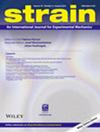Direct material property determination: One‐dimensional formulation utilising full‐field deformation measurements
IF 2.4
3区 材料科学
Q2 MATERIALS SCIENCE, CHARACTERIZATION & TESTING
引用次数: 1
Abstract
A direct approach is described to determine the elastic modulus distribution in a nominally heterogeneous material subject to tensile/compression loading and primarily experiencing deformations in the axial direction. The formulation is developed for uniaxial applications using basic theoretical constructs, resulting in a computational framework that has a matrix form [A] {E} = {R}, where the [A] matrix components are known functions of measured axial strains and axial positions, {R} components are known functions of axial body forces, applied loads and reactions and {E} components are the unknown elastic moduli at discrete locations along the length of the specimen. For a series of one‐dimensional (1D) material property identification procedure with known axial strains at discrete locations and various levels of random noise, results are presented to demonstrate the accuracy and noise sensitivity of the methodology. Finally, experimental measurements for a heterogeneous bone specimen are compared to our 1D model predictions, demonstrating that the predictions are in very good agreement with independent estimates at each load level of interest along the length of the bone specimen.直接材料性能测定:利用全场变形测量的一维公式
描述了一种直接方法来确定承受拉伸/压缩载荷并主要经历轴向变形的标称非均质材料中的弹性模量分布。该公式是使用基本理论结构为单轴应用开发的,产生了矩阵形式[a]{E}的计算框架 = {R} ,其中[A]矩阵分量是测得的轴向应变和轴向位置的已知函数,{R}分量是轴向体力、施加的载荷和反作用力的已知函数;{E}分量是沿试样长度的离散位置处的未知弹性模量。对于一系列在离散位置具有已知轴向应变和不同水平随机噪声的一维(1D)材料特性识别程序,给出了结果,以证明该方法的准确性和噪声敏感性。最后,将异质性骨样本的实验测量值与我们的1D模型预测值进行了比较,表明这些预测值与沿着骨样本长度的每个感兴趣的载荷水平下的独立估计值非常一致。
本文章由计算机程序翻译,如有差异,请以英文原文为准。
求助全文
约1分钟内获得全文
求助全文
来源期刊

Strain
工程技术-材料科学:表征与测试
CiteScore
4.10
自引率
4.80%
发文量
27
期刊介绍:
Strain is an international journal that contains contributions from leading-edge research on the measurement of the mechanical behaviour of structures and systems. Strain only accepts contributions with sufficient novelty in the design, implementation, and/or validation of experimental methodologies to characterize materials, structures, and systems; i.e. contributions that are limited to the application of established methodologies are outside of the scope of the journal. The journal includes papers from all engineering disciplines that deal with material behaviour and degradation under load, structural design and measurement techniques. Although the thrust of the journal is experimental, numerical simulations and validation are included in the coverage.
Strain welcomes papers that deal with novel work in the following areas:
experimental techniques
non-destructive evaluation techniques
numerical analysis, simulation and validation
residual stress measurement techniques
design of composite structures and components
impact behaviour of materials and structures
signal and image processing
transducer and sensor design
structural health monitoring
biomechanics
extreme environment
micro- and nano-scale testing method.
 求助内容:
求助内容: 应助结果提醒方式:
应助结果提醒方式:


